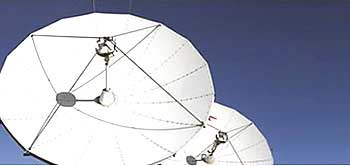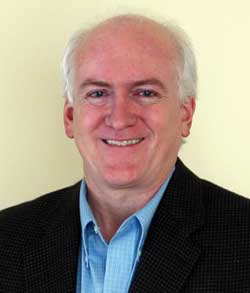February 2008 Edition
The American Satellite Market
Cover Story
North American Satellite Market Leads in New Applications ,
Features
Reducing the Cost and Complexity of Managing Satellite-based Networks,
Satellite communications represent a cost effective and reliable means of transporting voice, video and data to and from remote locations. However, as the adoption of satellite-based communication networks continues to grow, so do the management challenges. Bolstered by high-speed satellite links, network infrastructures are pushing farther into the most demanding remote areas – jungles, mountaintops, deserts, and oceans. Regardless of geographic location, operational, and IT staffs are expected to maintain high availability, reliability, and security of their satellite networks to deliver the business applications they run — a daunting task.
LaserCom For Better SatCom,
Crystal Balling the Transformed World of Ka-Band Broadband Services, Reprinted, with permission, from Northern Sky Research (NSR)’s Industry Status Briefing…
The word Mark Dankberg used on 8 January in describing the impact on ViaSat of their announcement of the new Viasat-1 satellite was “transformational”. In many ways, Viasat-1 has the potential to remake the company from a manufacturer of specialized satellite and wireless communications equipment to that of an infrastructure business that owns the underlying technological asset that gives rise to a large array of services, from consumer satellite broadband to mobile to video services possible.
Eye On Europe, Arqiva - Ready For Expansion!
Arqiva, amongst other assets, operates the United Kingdom’s largest Earth Station portfolio. A handful of years ago, the company itself was up for sale and was eventually acquired by Australian financial interests headed by Macquarie. Arquiva has since mopped up rivals and new businesses at an impressive rate. Its latest toy is operating much of the uplinking for the UK’s embryonic Freesat rival to BSkyB’s Sky Digital pay-TV operation.

The Dragon Lives!,
Regulatory
An Auspicious Start To The New Year,
This election year, there is yet another interesting twist affecting – indeed, infecting – telecom policymaking and legislative oversight that has not been present in prior election years (at least not in recent – meaning 50+ years) memory. Specifically, Chairman Martin’s management style and leadership of the U.S. Federal Communications Commission (FCC or Commission) has invited such criticism and vitriol that it has become the hallmark, indeed the symbol, of the Bush Administration.

Spotlight
Executive Spotlight On... Gary Hatch, President and CEO, ATCi
Executive Spotlight On... Stuart Daughtridge, Executive Vice President, Commercial Division
As executive team availability at Integral Systems can be intensely guarded, due to the press of business, obtaining the time necessary to converse with Stuart Daughtridge was quite momentous.

Stuart Daughtridge Interview Addendum, Providing the BIG Picture for Satellite Systems
Over the past decade, there has been a significant increase in the use of “enterprise solution” software to monitor, analyze, and improve business operations for various applications and corporations. Applied appropriately, these “business process management” (BPM) tools offer an effective way to visualize an organization’s activities and improve operational efficiency.
Executive Spotlight On... Tristan Wood, Managing Director, Livewire Digital Ltd
Tristan Wood is the Managing Director for the firm and is a specialist in communications and video distribution products for use over both satellite and terrestrial links. Tristan founded Livewire Digital in 1991 and he established healthy relationships with Inmarsat and other satellite service providers. His expertise covers maritime computer network installations that included security and communication solutions for maritime voice, live and store forward video as well as data comms.
An Event of MENA Proportions,
The Middle East often claims the media headlines. Recently this has, in part, been due to escalating oil prices, which pushes the GDP of the region’s oil producers sky-high. Even before the most recent oil-price “gushers”, Middle Eastern countries were realizing an average annual GDP growth of almost 6 percent. This level of economic expansion is well reflected in, and partly facilitated by, growth in the size of national telecom markets across the region.
Regular Departments
Editors Notes,
My firm belief as the editorial director of SatNews Publishers is that it is a highly worthwhile endeavor for SatMagazine, MilsatMagazine, SatNews, and digiGO! readers to become more familiar with those who help to “grow” our critically-needed products.
The History of Satellites, (Ongoing Series)
During the late 1950s and early 1960s, the relative merits of passive and active communication satellites were often discussed. Passive satellites merely reflect incident radiation, whereas active satellites have equipment that receives, processes (may be only amplification and frequency translation, or may include additional operations), and retransmits incident radiation.
Featured Satellite, SES AMERICOM — AMC-21 Satellite
Mid-year, AMERICOM-21, known as AMC-21, should launch. The spacecraft, being built by Alcatel Alenia Space, incorporates Orbital Sciences’ STAR-2 satellite bus. The lift-off will be via an Ariane 5 rocket from Europe’s Spaceport located in French Guiana.

Extracurricular Activity, SatPuzzle
Do you believe you’re the smartest individual to grace the satellite community since Arthur C. Clarke? Try your synapses on this satPuzzle…
SatFax,
Whether you use a satellite or cellular connection, or even a VoIP telephone system, faxing becomes a substantive issue. If you remained near your office fax machine and counted how many times a day coworker’s use the item, you would quite quickly realize faxing is not an endangered activity… it’s not going to go away in the near future.

